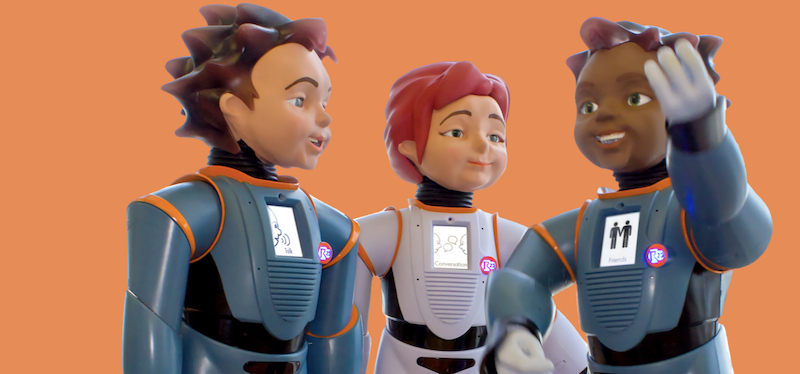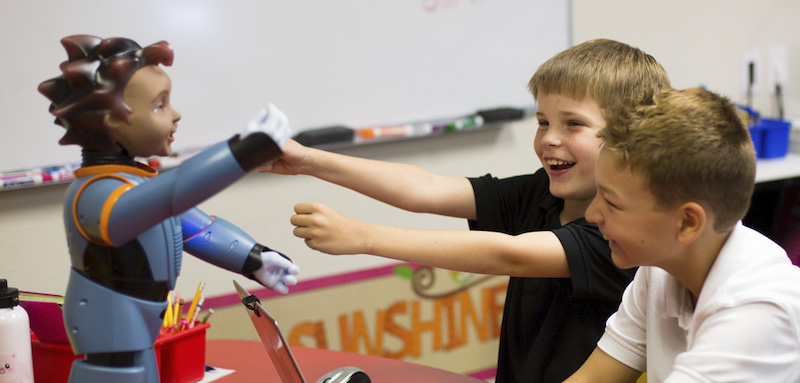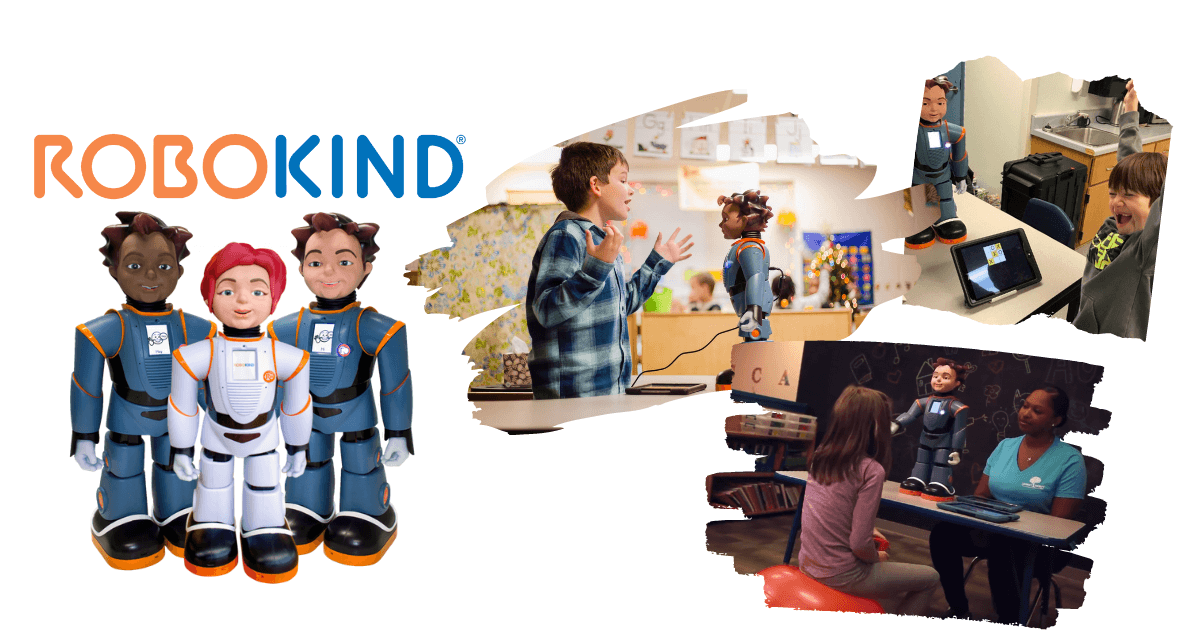The technology available to professionals in special education programs continues to evolve. We typically focus on STEM learning, but certainly can’t ignore the RoboKind robots for special education. The three different robots, Milo, Veda, and Carver, help students with learning differences meet their academic and social goals. They also help educators foster social connections with students, ultimately aid student emotional well-being, and even introduce them to coding down the line.
The facially-expressive robots mimic human interaction with proprietary technology powering them. Their facial expressions are incredibly similar to those made by real people. And, of course, Milo, Veda, and Carver can walk and talk. Each is compatible with RoboKind’s evidence-based curriculum, moving them from toys to learning tools. Depending on existing needs and resources, educators could roll out these personalized solutions in a single school or even district-wide.
Each of the robots offers something different for students and teachers. Overall, however, they each positively impact special education and SEL outcomes. Especially for students involved with individual education plans (IEPs), the RoboKind robots are a game changer. Students with learning differences benefit from the specially designed and SEL-focused RoboKind curricula and routinely see quick improvements in speech, pragmatics, and behavior. The robots also serve as great tech components in MTSS programs, including helping students learn to be more efficient in completing tasks and increasing mastery levels.

The robots’ social features are among the most advanced you’ll find. Whether educators use these robotics tools with special education students or in STEM programs, they’re able to help kids develop new skills that are relevant to them. The RoboKind solutions personify inclusion and each one of them succeeds at doing so. Milo, Veda, and Carver are all excellent examples of assistive technology. Each make an immediate and long-term impact on students who need some extra attention in the classroom.
In terms of instruction, educators can use the RoboKind robots in many different scenarios. These include blended learning, virtual learning, self-paced learning, remote learning, and, of course, in schools. There are synchronous and asynchronous learning resources available to use with the robots as well as the option to set up virtual sessions with teachers, therapists, and other special education professionals. And, since we’re still in the remote learning age, their pre-recorded videos for teaching with each robot are also valuable. To learn more about the different instructional models associated with Milo, Veda, and Carver, feel free to contact us.
As for the RoboKind curriculum, there are four different choices. These include Autism and SEL, Autism and SEL: Avatar, robots4autism: At Home, and Coding and Computer Science. The Autism and SEL curriculum is commonly referred to as robots4autism. It helps drive learning outcomes and provides these students with lasting results.
This curriculum is compatible with all three robots and helps students learn to engage in social situations. They'll also learn to better understand facial expressions and self-regulate their apprehensions in stressful situations. The purposeful curriculum helps students gain a better understanding of social narratives. It also helps improve verbal and visual prompting, boosts social skills, and extends their core vocabulary among other benefits.

Next, we have the Autism and SEL Avatar, which is the RoboKind solution for remote education. It’s built to support special educators who are unable to physically connect with students at the moment. The virtual version of Milo works just like the actual robot. Of course, since it's accessible digitally, teachers (or parents) don’t need to have the robot there with them. They’ll still be able to progress through the curriculum and leave students feeling better about where they’re at.
Then, there’s the robots4autism: At Home curriculum. This curriculum helps students continue their social and emotional development outside of the classroom. It features seven weeks of simple, downloadable lesson plans to help students learn more about succeeding in different social situations. There are also video resources available to accompany the lesson plan content. Topics covered include lessons in calming down, lessons in greetings, how to properly leave someone, how to recognize different emotions, and how kids can play with others.
Finally, we have the Coding and Computer Science curriculum. This option is often used with Carver and helps students move beyond the screen. It also features elements designed to increase college and career readiness. The lessons are created to help them think critically, collaborate to find creative solutions, communicate with others more effectively, and discover how to use technology to impact various elements of their world. It’s a truly robust curriculum and covers some of the most important computer science concepts. Whether it’s variables, algorithms, designing programs, conditionals, or even digital citizenship, students can learn all this and more with the Coding and Computer Science curriculum!
Now, for the robots themselves. We mentioned there are three robotics tools for Autism and STEM purposes: Milo, Veda, and Carver. Starting with Milo, this is RoboKind’s flagship robotics solution. It supports social-emotional development for students who have Autism Spectrum differences, specifically. Both educators and therapists use Milo with their students. Among the benefits the robot provides is advancing student outcomes in individual and small group learning. It also helps increase student engagement through its body language, social interactions, and eye contact, making Milo a fantastic tool for connecting with hard-to-reach students.

Then, we have Veda, the robot that serves as RoboKind’s teaching assistant. This robot helps teachers learn more about how to code with a purpose and lead coding instruction across the curriculum. Veda is often greeting students at the door of the classroom (when in-person learning is possible), introducing them to new lessons, explaining new concepts, and leading more individualized learning. Veda is the world’s first facially-expressive female humanoid. It's also used specifically with girls who may need some extra encouragement to try new things.
Last but not least, we have Carver. Carver serves as RoboKind’s STEM leader and helps students of all abilities learn more about coding and other STEM initiatives. As the world’s first dark skin humanoid robot, Carver can help educators learn more about meeting computer science standards in the classroom. Furthermore, with the skills and knowledge they learn from working with Carver, educators can become more equipped to prepare students with the necessary computer science skills for the future. And, like the other robots, Carver offers a non-threatening presence for students with learning differences. This allows them to practice communication skills, social skills, and more!
When paired with the RoboKind curriculum, all three RoboKind robots offer amazing personalized learning opportunities. In addition to new STEM skills, students who need extra support will learn things like how to tune in on emotions, express empathy, act appropriately in social situations, motivate themselves, and generalize in the population. If you’re interested in learning more about the RoboKind robots, we certainly encourage you to contact the Eduporium team. We can assist with selecting the right robot and potentially offer special pricing on the purchase of two or more units. For now, we can provide quotes and we anticipate being able to accept orders shortly. Follow us on Twitter and Instagram for more!




Kim Stevens
252-809-9389